ISSN ONLINE(2319-8753)PRINT(2347-6710)
ISSN ONLINE(2319-8753)PRINT(2347-6710)
Amit Nara1, Sahil Takhi2
|
| Related article at Pubmed, Scholar Google |
Visit for more related articles at International Journal of Innovative Research in Science, Engineering and Technology
Wire electric discharge machining (WEDM) is a special thermal non-traditional machining process in which the material is removed from the work-piece by a discrete spark between the work-piece and the conductive wire which has ability to generate complicated shapes of varying hardness with high accuracy and precision. In present work, WEDM process has been performed to finish weld beads developed on mild steel specimens using various process parameters like weld bead, Input current (I/P), Pulse-On (Ton), Servo voltage (SV), Wire feed (WF) were used. The paper describes the development of single response optimization using Taguchi method to predict the optimal setting of machining of wire electric discharge machine. Experiment were conducted using L18 orthogonal array and the response characteristics for above process parameters were Cutting Speed (C.S) and Surface roughness (S.R) using taguchi approach to find out the optimal process parameter setting. ANOVA was used to find out the level of significance of machining parameters and finally in the end the confirmation experiment was conducted to validate the effectiveness of the present work.
KEYWORDS |
| Mild steel, WEDM, L18 orthogonal array, S/N ratio, ANOVA |
I. INTRODUCTION |
| WEDM is very similar to conventional EDM process involving the erosion effect produced by electric discharge b/w the work piece and conductive wire. The material removal take place when the voltage supply increases beyond the breakdown voltage the dielectric fluid gets ionized due to which the electron strikes the work-piece and vaporise the part of the material. This process finds suitable application in automotive aerospace, mould, tool and die making industry. It has also made a significant inroad in medical, optical, dental and jewellery industry. It is also used to produce shapes which are extremely difficult to otherwise. Viz. square, D hole, Splines etc. |
II. EXPERIMENTAL SET-UP AND SELECTION OF PROCESS PARAMETERS |
| The pulse generator capacity of the machine is 40A. The pulse generator supplies the electrical energy to the spark gap in the form of pulses. The machine tool unit comprises of a main worktable (called X-Y table) by which the work piece is clamped on auxiliary table (called U-V table) and wire drive mechanism. Figure 1. shows the experiments are carried out in CNC sprint cut wire EDM of Electronic a Machine tool ltd. Figure 2. shows the stepwise procedure for Taguchi experimental design and analysis. |
III. WORK PIECE ELECTRODE |
| The work piece material used in this investigation was mild steel. The carbon percentage in mild steel varies between 0.15-0.30%. The workpiece was machined on a milling machine FN2V (HMT) to prepare the specimen in the size of 200x43x27 mm. |
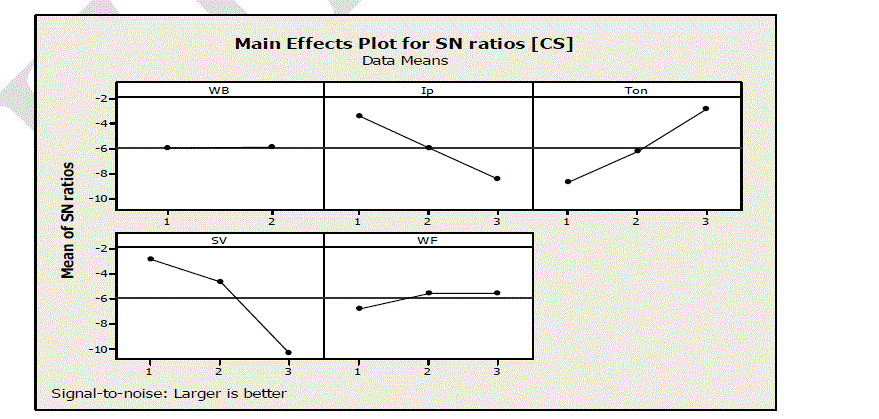 |
IV. TOOL ELECTRODE |
| Zinc coated copper wire having dia of 0.25mm is used in the present investigation as the electrode. Zinc coated Copper wire electrode can conduct high current as compare to simple copper wire. |
V. SELECTION OF PROCESS PARAMETERS AND THEIR RANGES |
| In order to obtain high cutting speed, accurate dimension, better quality of surface roughness and the Good Material removal rate can be obtained by WEDM process. The optimal level of WEDM process parameters need to be determined. Based on the critical review of literature, process variables of the WEDM are selected according to transient state. |
| The process parameters selected for this study are as following: |
| a. Weld bead |
| b. Discharge Current |
| c. Pulse-on time |
| d. Servo voltage |
| e. Wire Speed |
| In Sprint-cut WEDM, the value of current ranges b/w 10 to 230A, Pulse-ON time b/w 110 to 131, Servo voltage 10- 90V and Wire speed 1-15m/min |
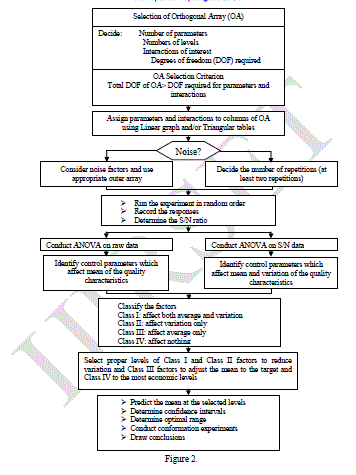 |
VI. SELECTION OF ORTHOGONAL ARRAY (OA) AND PARAMETER ASSIGNMENT |
| Before selecting a particular OA to be used as a matrix for conducting the experiments, the following two points are first considered: |
| 1. The number of parameters and interactions of interest. |
| 2. The number of levels for the parameters of interest. |
| Degree of freedom (DOF) associated with each factor is equal to no. of level -1. Therefore, total degree of freedom for the five factors is (1+2+2+2+2) 9. As per Taguchi’s method, the total DOF of selected OA must be greater than or equal to the total DOF required for the experiment. So, L18 OA having 17 (=18-1) degree of freedom is selected for the present analysis. The experiments are conducted at each trial conditions as given in table 2. For each trial, the experiments is repeated by three times. |
 |
VII. RESULT AND DISCUSSION |
| In this section, we are discussing the effect of WEDM process parameters( peak current, pulse on time, pulse off time, current, wire speed and wire tension) on the basis of response characteristics(cutting speed and surface roughness). The average value of response characteristics, mean data and S/N ratio for each parameter, at all levels, is calculated from table 3. These effects are plotted by using MINITAB 15 SOFTWARE |
Effect Of Parameters On Cutting Speedc |
| Average value of Cutting speed calculated from raw data is 0.582mm /min. It is clear from the S/N plots. That the maximum S/N ratio occurs correspond to A2,B1,C3,D1,E3.Therefore, the optimum value will correspond to these factors but only the significant factor would be chosen. This factor will be chosen from the ANOVA table. |
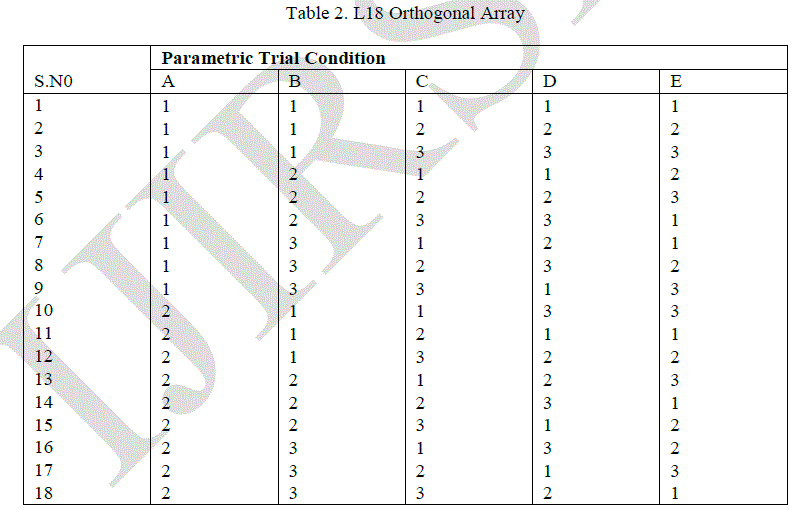 |
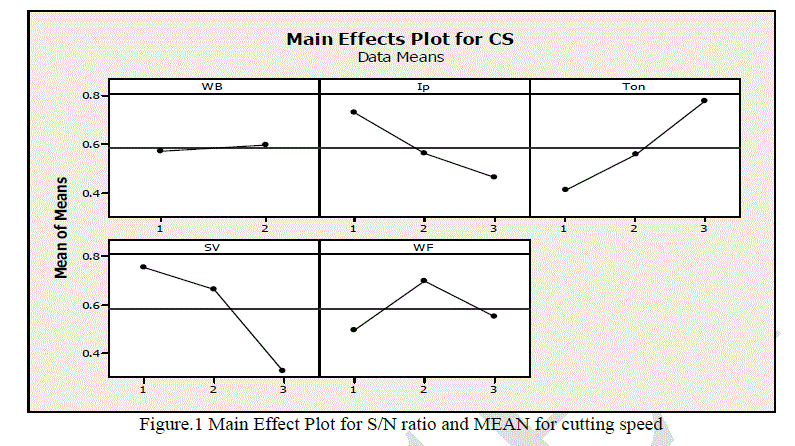 |
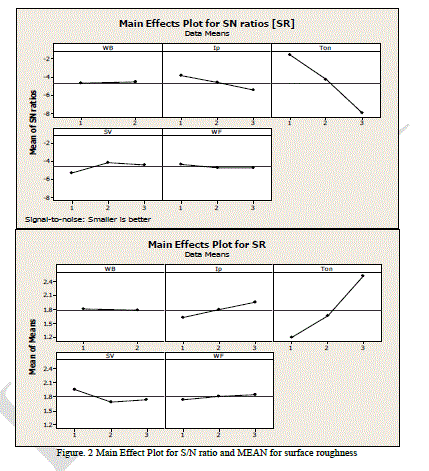 |
Effect of Parameters On Surface Roughness |
| Surface roughness is a key factor in die making and depends upon the energy drop across the electrodes. Surface roughness is a “smaller is better” type characteristics. So, the optimum value of surface roughness should be low so that depth of recast layer remains minimum or equal to zero. Average value of surface roughness is 0.969μm. It is clear from the S/N plots. That the maximum S/N ratio occurs correspond to A2,B1,C1,D2,E1.Therefore, the optimum value will correspond to these factors but only the significant factor would be chosen. This factor will be chosen from the ANOVA table Main effects of each parameter are calculated from response table 5 and 6 as shown in fig 2. These effects are plotted by using MINITAB 15. |
 |
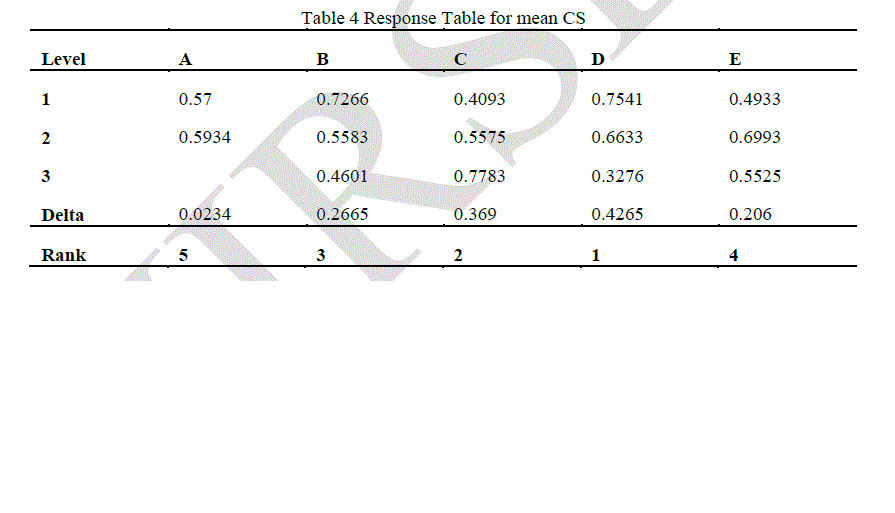 |
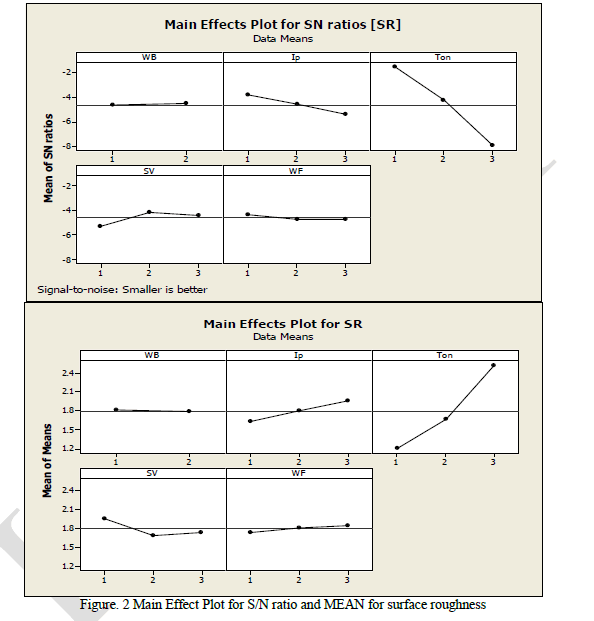 |
VIII. CONFIRMATION EXPERIMENT |
| It is conducted for the cutting speed and for surface roughness. The experimental value obtained at the optimal setting of parameter is: |
| Cutting speed = 1.11m/min |
| Surface roughness = 1.02μm |
IX. CONCLUSION |
| On the basis of above studied experiments, it can be safely concluding that:- . |
| • The cutting speed are mostly affected by the peak current (Ip), pulse-on time (Ton) and servo voltage (SV). |
| • Surface roughness are mostly affected by the peak current (Ip), pulse-on time (Ton) and servo voltage (SV). |
References |
|